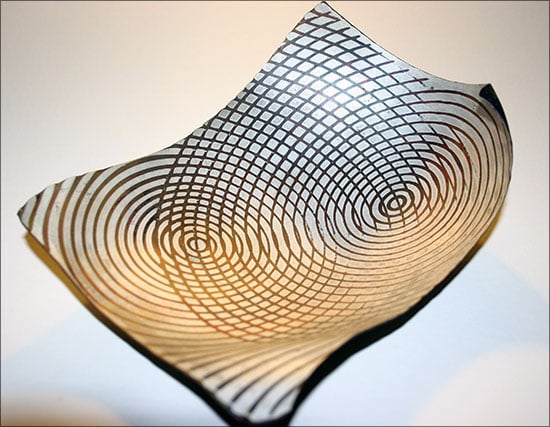rials: Sterling silver and fine copper
Dimensions: 7 inches x 9 inches x 3.5 inches deep
This Sheffield Plate bowl was born of the furnace and the forge, using the techniques of the “Sheffield Plate” workers of 18th century England to create a contemporary piece of metal work. The sterling silver was fused to fine copper in a furnace to create a silver/copper laminated billet. The silver is about 10th the thickness of the copper. The billet was then beaten, forged and annealed to ensure perfect joining of the two metals. It was then rolled out a bit, the pattern was then cut through the silver layer using a lathe. It was then rolled out again into a sheet, by which time the copper had filled the cuts created on the lathe. The sheet was then formed into the bowl you see here using a boxwood doming mallet and a leather sandbag. The outside shape was not trimmed and the surface was gently scoured to a fine matte finish, the bowl was then gently heated in a flame to oxidize the copper and bring out the pattern. It has no function other than being decorative, I hope you find it interesting.
Photo credit: Hamish Bowie
Hamish Ian Cameron Bowie
Birmingham, UK
Jewellery designer/retired teacher and metal-smith with 50 years experience. I am still making drawing ideas and researching. The items I am submitting are born of the furnace, forge and fire. They represent the latest of my experimental work in diffusion bonding, inspired by the techniques of the 18th century English Sheffield Plate workers based in Birmingham and Sheffield.
These containers and vessels definitely hold their place in the world of stunning art objects as well as in the world of metalsmithing.
Since the dawn of time humans have created containers to hold things that were important to them, from large vessels to hold food and harvests to intimate containers for small precious things. They might hold memories, ashes, medicine, beverage, fruit or food - but all spring from the imagination and skill of the maker. Some have specific religious functions, some are meant for everyday use. When one thinks of a vessel or container the inclination is to think of something with solid walls - yet many of these works involve the exploration of positive and negative space, and the use of negative space to help create the illusion of the wall of the vessel.
As the world’s largest jewelry related internet site, Ganoksin strives to develop exhibitions showcasing work from around the world. This exhibition was open to all metalsmiths, professional and amateur, advanced and beginner. Participants are from The Netherlands, the USA, Canada, Australia, Costa Rica, the United Kingdom, Israel, Hong Kong, Colombia, Romania, Italy, Ireland, Japan, Malaysia and Denmark. While most of the pieces are by an individual metalsmith, some are collaborations, one of three artists spanning 50 years.
In total 319 artists contributed 729 show pieces for the permanent online exhibition.
Objects in the exhibition include boxes, lockets, urns, ash containers, bowls, wine cups, reliquaries, match holders, vases, teapots, pitchers, sugar bowls, baskets, nests, pillboxes, clutches and a range of sculptural forms. A variety of techniques are showcased covering a wide range of metalsmithing techniques. Materials used include everything from gold and silver to less expensive metals. Ornamentation includes the addition of enamel, chasing and repousse’, gemstones and found objects.
The exhibition was curated by Beth Wicker, President of the North Carolina Society of Goldsmiths in the United States, and Adjunct Instructor at Northeastern Technical College in South Carolina. Director of the exhibition is Hanuman Aspler, founder of The Ganoksin Project, the world’s largest internet jewelry site.
